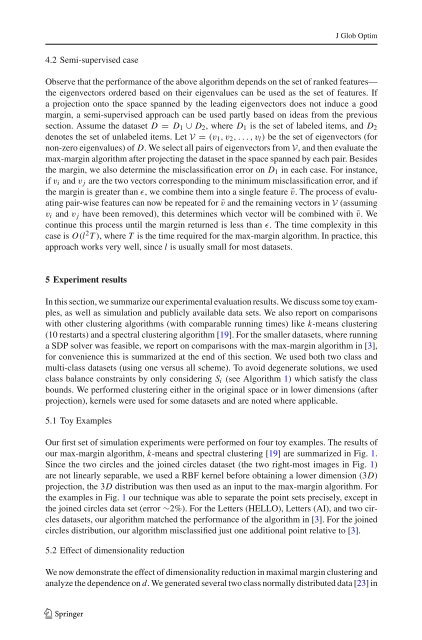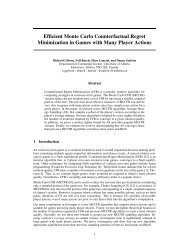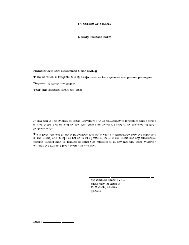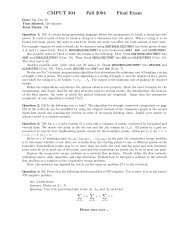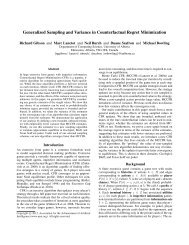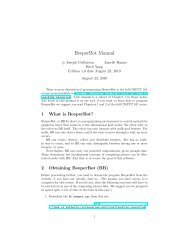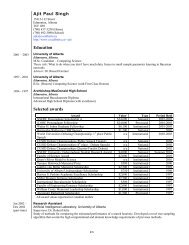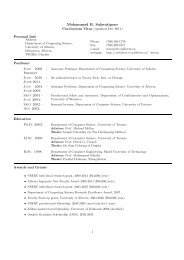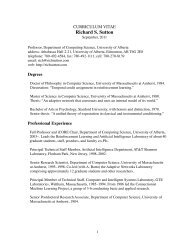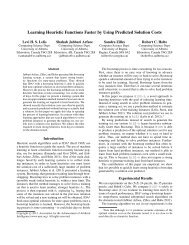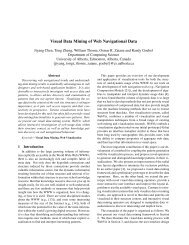An efficient algorithm for maximal margin clustering - ResearchGate
An efficient algorithm for maximal margin clustering - ResearchGate
An efficient algorithm for maximal margin clustering - ResearchGate
You also want an ePaper? Increase the reach of your titles
YUMPU automatically turns print PDFs into web optimized ePapers that Google loves.
J Glob Optim<br />
4.2 Semi-supervised case<br />
Observe that the per<strong>for</strong>mance of the above <strong>algorithm</strong> depends on the set of ranked features—<br />
the eigenvectors ordered based on their eigenvalues can be used as the set of features. If<br />
a projection onto the space spanned by the leading eigenvectors does not induce a good<br />
<strong>margin</strong>, a semi-supervised approach can be used partly based on ideas from the previous<br />
section. Assume the dataset D = D 1 ∪ D 2 ,whereD 1 is the set of labeled items, and D 2<br />
denotes the set of unlabeled items. Let V = (v 1 ,v 2 ,...,v l ) be the set of eigenvectors (<strong>for</strong><br />
non-zero eigenvalues) of D. We select all pairs of eigenvectors from V, and then evaluate the<br />
max-<strong>margin</strong> <strong>algorithm</strong> after projecting the dataset in the space spanned by each pair. Besides<br />
the <strong>margin</strong>, we also determine the misclassification error on D 1 in each case. For instance,<br />
if v i and v j are the two vectors corresponding to the minimum misclassification error, and if<br />
the <strong>margin</strong> is greater than ɛ, we combine them into a single feature ¯v. The process of evaluating<br />
pair-wise features can now be repeated <strong>for</strong> ¯v and the remaining vectors in V (assuming<br />
v i and v j have been removed), this determines which vector will be combined with ¯v. We<br />
continue this process until the <strong>margin</strong> returned is less than ɛ. The time complexity in this<br />
case is O(l 2 T),whereT is the time required <strong>for</strong> the max-<strong>margin</strong> <strong>algorithm</strong>. In practice, this<br />
approach works very well, since l is usually small <strong>for</strong> most datasets.<br />
5 Experiment results<br />
In this section, we summarize our experimental evaluation results. We discuss some toy examples,<br />
as well as simulation and publicly available data sets. We also report on comparisons<br />
with other <strong>clustering</strong> <strong>algorithm</strong>s (with comparable running times) like k-means <strong>clustering</strong><br />
(10 restarts) and a spectral <strong>clustering</strong> <strong>algorithm</strong> [19]. For the smaller datasets, where running<br />
a SDP solver was feasible, we report on comparisons with the max-<strong>margin</strong> <strong>algorithm</strong> in [3],<br />
<strong>for</strong> convenience this is summarized at the end of this section. We used both two class and<br />
multi-class datasets (using one versus all scheme). To avoid degenerate solutions, we used<br />
class balance constraints by only considering S i (see Algorithm 1) which satisfy the class<br />
bounds. We per<strong>for</strong>med <strong>clustering</strong> either in the original space or in lower dimensions (after<br />
projection), kernels were used <strong>for</strong> some datasets and are noted where applicable.<br />
5.1 Toy Examples<br />
Our first set of simulation experiments were per<strong>for</strong>med on four toy examples. The results of<br />
our max-<strong>margin</strong> <strong>algorithm</strong>, k-means and spectral <strong>clustering</strong> [19] are summarized in Fig. 1.<br />
Since the two circles and the joined circles dataset (the two right-most images in Fig. 1)<br />
are not linearly separable, we used a RBF kernel be<strong>for</strong>e obtaining a lower dimension (3D)<br />
projection, the 3D distribution was then used as an input to the max-<strong>margin</strong> <strong>algorithm</strong>. For<br />
the examples in Fig. 1 our technique was able to separate the point sets precisely, except in<br />
the joined circles data set (error ∼2%). For the Letters (HELLO), Letters (AI), and two circles<br />
datasets, our <strong>algorithm</strong> matched the per<strong>for</strong>mance of the <strong>algorithm</strong> in [3]. For the joined<br />
circles distribution, our <strong>algorithm</strong> misclassified just one additional point relative to [3].<br />
5.2 Effect of dimensionality reduction<br />
We now demonstrate the effect of dimensionality reduction in <strong>maximal</strong> <strong>margin</strong> <strong>clustering</strong> and<br />
analyze the dependence on d. We generated several two class normally distributed data [23]in<br />
123


